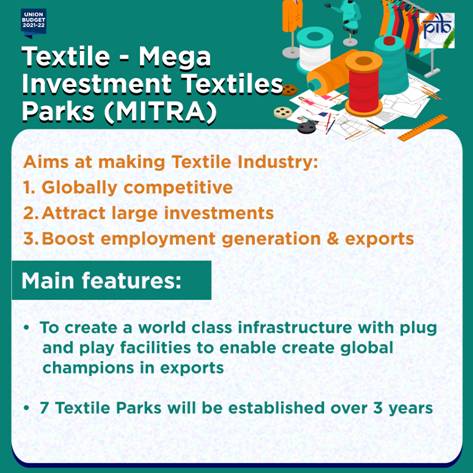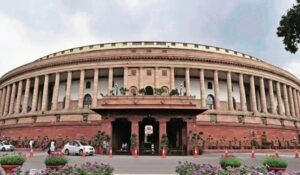Context
-
Recently, Finance minister has proposed MITRA Scheme i.e. Mega Investment Textiles Parks (MITRA) for Textile sector in her budget speech of 2021.
Key Details about MITRA Scheme
- The scheme will enable the textile industry to become globally competitive.

- It will also attract large investments, boost employment generation and exports.
- Scheme aims to create world class infrastructure with plug and play facilities to enable create global champions in exports.
- MITRA will be launched in addition to the Production Linked Incentive Scheme(PLI).
- Government also announced uniform deduction of the BCD rates on caprolactam, nylon chips and nylon fiber and yarn to 5 per cent.
Back to basics
What is the production linked incentive scheme?
- In order to boost domestic manufacturing and cut down on import bills, the central government in March this year introduced a scheme that aims to give companies incentives on incremental sales from products manufactured in domestic units. Apart from inviting foreign companies to set shop in India, the scheme also aims to encourage local companies to set up or expand existing manufacturing units.
- The objective is really to make India more compliant with our WTO (World Trade Organisation) commitments and also make it non-discriminatory and neutral with respect to domestic sales and exports.
- Recently, The government aims to expand the ambit of the production-linked incentive (PLI) scheme to include as many as ten more sectors such as food processing and textiles other than the already included mobile phones, allied equipment, pharmaceutical ingredients and medical devices.
Why is the production linked scheme needed?
- The idea of PLI is important as the government cannot continue making investments in these capital intensive sectors as they need longer times for start giving the returns. Instead, what it can do is to invite global companies with adequate capital to set up capacities in India.
- The kind of ramping up of manufacturing that we need requires across the board initiatives, but the government can’t spread itself too thin. Electronics and pharmaceuticals themselves are large sectors, so, at this point, if the government can focus on labour intensive sectors like garments and leather, it would be really helpful.
Which sectors currently have the PLI scheme?
- As a part of the PLI scheme for mobile and electronic equipment manufacturing, an incentive of 4-6 per cent is planned for electronics companies which manufacture mobile phones and other electronic components such as transistors, diodes, thyristors, resistors, capacitors and nano-electronic components such as micro electromechanical systems.
For More such Government Schemes / Initiatives: Click Here

